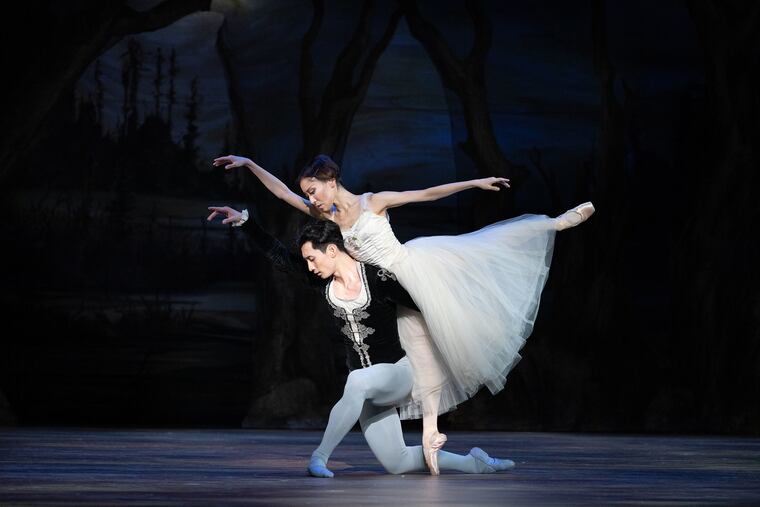Philadelphia Ballet opens ‘Giselle’ with beautiful dancing and a seamlessly diverse cast
With a diverse cast of dancers in a 'white ballet,' Angel Corella has finally and smoothly made the ballet more welcoming and representative of its community.

Nutcracker and Swan Lake may have transcended the ballet world to become a part of popular culture, but Giselle is nearly as beloved.
Philadelphia Ballet opened Angel Corella’s version of Giselle Thursday night at the Academy of Music, and it did not disappoint.
Yuka Iseda danced the role of Giselle, a charming young girl who delights in dancing but has a weak heart. Zecheng Liang was Count Albrecht, who pretends to be a villager and woos her with his attention and charms, but is actually a nobleman betrothed to another.
Their dancing was engaging, both together and solo. Iseda played her Giselle more hopeful than gullible, with beautiful feet and stretched extensions making her the best dancer in the village. Liang matched her extensions and leaps, and was physically supportive. But their romantic chemistry could have been stronger in Act 1.
Austin Eyler was Hilarion, a local gamekeeper also in love with Giselle and suspicious of Albrecht. It is he who eventually finds Albrecht’s noble sword and horn that leads to the truth. Eyler is correctly brusque and demanding as Hilarion, making it clear why he is not Giselle’s type.
» READ MORE: Pennsylvania Ballet’s lovely ‘Giselle’ is more classic than it is Corella
While Iseda is not the most naive Giselle, her acting is strong once Albrecht and his engagement are found out. Much to her mother’s distress, she dances herself into a mad frenzy and eventually her heart gives out. Iseda goes from her love for Albrecht, to pulling herself together, to dancing alone, and finally to collapsing in her mother’s arms with a full range of emotion.
Thursday night, Sydney Dolan and Pau Pujol danced the peasant pas de deux. Both were delightful, but Dolan’s dancing is stronger, cleanly finishing every turn and movement. She often seemed not to need the assistance of Pujol, who occasionally had to steady himself.
The corps is delightful filling out the Act 1 courtyard scene. But it — or at least the women — really come alive, ironically, in Act 2, as the Wilis, the dancing dead. They were all jilted before they made it to the altar as brides, and Dayesi Torriente is Myrtha, their queen when Giselle is inducted into their sorority.
Both Hilarion and then Albrecht run after Giselle. Hilarion’s friend pulls him from the Wilis’ clutches, but Albrecht is determined. He dances near, almost through the ghostly Giselle, showing their strongest attachment.
In the end, Giselle saves Albrecht from Myrtha’s will of making him dance to his death.
Torriente’s Myrtha is cold and vengeful, her dancing both soft and powerful. She is one of the better dancers in the company but not always the most emotional, so this role shows her strengths.
Myrtha and the Wilis are all dressed in white, which is why Giselle is often referred to as a “white ballet.” This has been called out as problematic in recent years, as dancers of color have often been excluded from the roles or asked to lighten their skin with makeup.
But while the ballet world has been slow to diversify, Philadelphia Ballet included, there were several Black dancers in this scene. To Corella’s credit, he did not try to separate them from the group in any way — and it worked. I mostly noticed because I was looking for these dancers.
This cast was one of the most diverse this company has put on stage, with both Giselle and Albrecht played by Asian dancers, and several BIPOC dancers filling out the cast.
Very slowly, Philadelphia Ballet is starting to look more like its community. It’s a welcome and seamless change.
Philadelphia Ballet in “Giselle,” through Sunday and March 9-10. Academy of Music, 240 S. Broad St. Tickets start at $25. 215-893-1999 or kimmelculturalcampus.org